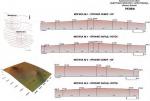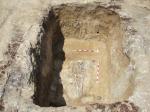Summary (English)
EXPLORATIONS NEAR THE VILLAGE OF BRESTOVITSA (Varbin Varbanov – ramonearhaeology@abv.bg) Tumulus No. 1 was 50 m in diameter and 1.60 m in height. The primary mound was documented in its center, 15 – 17 m in diameter and 1.40 – 1.60 m in height, containing bones from domestic animals, fragmentary wattle-and-daub and plaster from floors of houses and hearths, over 8500 sherds of the 6th – 4th centuries BC, fragments from bronze objects, 31 spindle whorls, a loom weight, an iron knife, a whetstone, a quern, a small ceramic vessel, a terracotta bead and a bi-spiral fibula of the 7th – 6th century BC. Four rectangular platforms of clay were documented, 2/2.10 m in size, situated each above other in the center of the tumulus. Tumulus No. 2 was situated at 25 m to the southeast of Tumulus No. 1 and was 40 m in diameter and 2 m in height. Three ceramic bowls and a pot were discovered in the southwestern sector. A burial pit was explored in the tumulus’ center, 4.10/4.20 m by 2.10/2.30 m in size, 1.90/2 m in depth, dug out into the ancient terrain and framed with timber beams. A spindle whorl and a fragmentary jug were found inside the pit. The dead was a woman, 35 – 40 years old, oriented north – south, with her head to the north. A small iron tube and two silver omega-like pendants were found close to the skull and a bronze fibula of the Thracian Type was found on the left side of the chest. A small iron knife, four small iron balls and an iron spearhead were discovered close to the skeleton. Over 1720 sherds were found in the tumular embankment, 75% of them discovered in the northern half of the tumulus. A platform of burned soil, ash and small pieces of charcoal was documented in the northwestern sector, with three piles of sherds and a spindle whorl over it. A second platform of plaster, ash and small pieces of charcoal was documented in the northeastern sector with a pot and sherds over it. The dated finds were a lekane and a jug of the middle of the 6th – middle of the 4th century BC, the omega-like pendants of the second quarter of the 5th – beginning of the 3rd century BC and the fibula of the middle of the 5th – middle of the 4th century BC. The burial dated to the end of the 5th – beginning of the 4th century BC.
- Varbin Varbanov - Regional Museum of History – Ruse
Director
Team
Research Body
- Regional Museum of History – Ruse






![Download [PDF]](/excavation/skins/fasti/images/results/download_sml.png)

